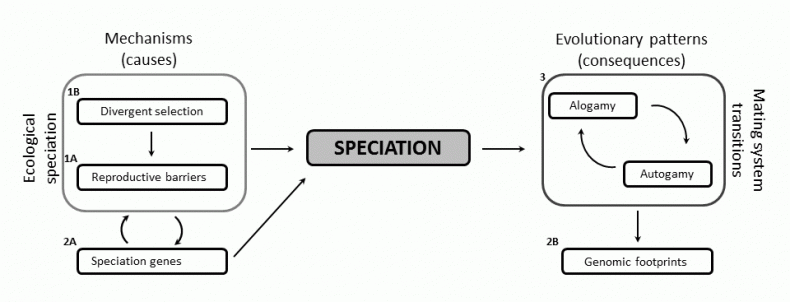Mechanisms of speciation in plants associated to mating system transitions (TransSpeciation) is a scientific project funded by the Spanish Ministry of Economy and Innovation.
Abstract
The speciation process triggers the emergence of new species and its study helps not only with understanding evolutionary questions but also with a better management of the natural biodiversity. The causes and consequences of speciation have drawn the attention of scientists from the beginnings of the evolutionary biology. However, while the ecological mechanisms and consequences of speciation were extensively explored in many organisms during decades, it was not until recent years, with the vertiginous development and increasing affordability of new sequencing technologies, when integrated approximations to the study of speciation, including its genomic aspects, have become increasingly feasible. The causes of speciation lie in a continuous interaction between ecological and genetic mechanisms. The importance of natural selection for creating barriers to gene flow between diverging taxa (ecological speciation) has been recognised. However, there are only few examples in which the identification of the selective pressures and reproductive barriers driving speciation were accompanied by the identification of genes underlying the speciation process and its consequences on diverging taxa. One of this consequences is the evolutionary transitions between diferent mating systems in plants. An adequate choice of a study system allowing the multidisciplinary exploration of these questions as a whole is crucial.
 In this project, I will study a close related group of taxa included in two species belonging to the genus Erysimum L.: E. incanum and E. wilczekianum. Although both species share many phenotypic and habit similarities, they strongly differ in floral sizes and pollinator assemblages. A multidisciplinary approach including the evaluation of the reproductive barriers and the study of the selective pressures driving them, together with the identification of the genes underlying these species divergence will be carried out. Finally, the consequences of this speciation event will be explored by the assessment of the phylogenetic relationship and the functional genomic consequences of the mating system transition.
In this project, I will study a close related group of taxa included in two species belonging to the genus Erysimum L.: E. incanum and E. wilczekianum. Although both species share many phenotypic and habit similarities, they strongly differ in floral sizes and pollinator assemblages. A multidisciplinary approach including the evaluation of the reproductive barriers and the study of the selective pressures driving them, together with the identification of the genes underlying these species divergence will be carried out. Finally, the consequences of this speciation event will be explored by the assessment of the phylogenetic relationship and the functional genomic consequences of the mating system transition.
Team
PI: Mohamed Abdelaziz
Collaborators: M. Bakkali, JM Gómez, F. Perfectti
